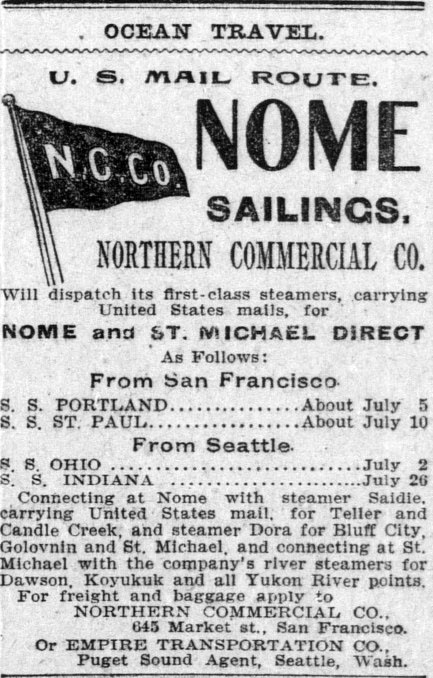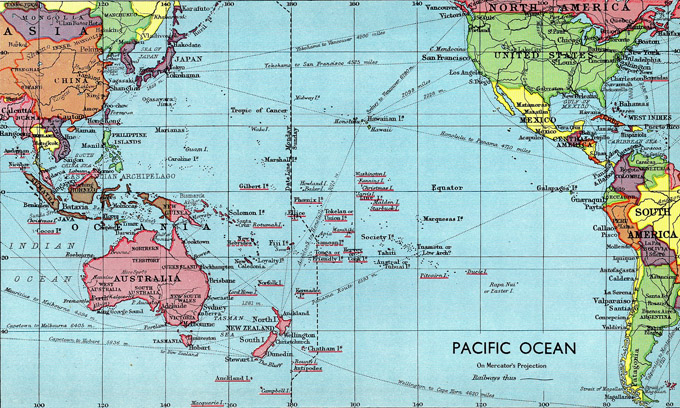Shipwrecks in Pacific Waters: 1800s

° Passenger Ship Arrivals
SS Ohio
SS Ohio was an 3488 ton, 343 foot long iron passenger-cargo steamship built by William Cramp & Sons in 1872-1873 for the transatlantic trade. The ship was one of the largest iron ships to had been built in the Unites States at the time of construction. She ran between Liverpool and Philadelphia from 1875 through 1896. In 1887, James Howden of Glasgow rebuilt and fitted her with triple expansion engines.
Following the discovery of gold in Alaska in 1896, great demand was created for American-flagged ships to transport gold prospectors to Alaska during the resulting gold rush. Clement Acton Griscom, the executive head of the Inman Line, took advantage of this demand to sell the ageing and outdated Pennsylvania class vessels at a premium.
On March 5, 1898, Ohio sailed from Philadelphia to San Francisco on the Pacific Coast. There, the vessel was sold to the Alaska Steamship Company, and subsequently commenced servicing the Seattle-Nome route, which she was to maintain to the end.
Empire Transportation Company
April 24, 1898, Burlington Hawk Eye, Burlington Iowa.
To Alaska

We have before us the prospectus of the Empire Transportation Company. The company will operate a line of steamers between the Pacific coast and Alaska ports and also a fleet of vessels on the Yukon river to the gold fields. The Empire Transportation Company us owned by the International Navigation Company, better known as the American Line, between New York and Southampton and Philadelphia and Liverpool, and the Red Star Line, between New York and Antwerp and Philadelphia and Antwerp. The steamers employed in the Alaskan service have been in the Trans-Atlantic service and are the well known steamers Ohio, Pennsylvania, Indiana, Illinois and Conemaugh: the Yukon river boats are especially built for this service and carry passengers and freight through to the gold fields.
The Empire Transportation Company being under the management of the International Navigation Company is an assurance of responsibility and good service. The representative for Burlington and vicinity is Mr. Charles Sponholtz, to whom all should apply who desire further information.
June 13, 1900, San Francisco Call, San Francsico, California, U.S.A.
EMPIRE LINE
SS Ohio, from Seattle to Nome and St" Michael, May 24th. Subsequent sailings from Seattle to Nome, St. Michael and Yukon River Points, June 30, July 31, August 30. For rates and other information apply to:
EMPIRE TRANSPORTATION CO.
30 Montgomery Street
June 30, 1902, San Francisco Call, San Francisco, California

April 17, 1905, Logansport Reporter, Logansport, Indiana, U.S.A.
RUSH FOR GOLD GREAT AS EVER
No Cessation in Rush for the Klondike Gold Fields
Fever for Artic Exploration with Prospects of Wealth Still Consumes Many
Alaskan Stampedes are Changeable as the Styles in Easter Bonnets
. . .The voyage from Seattle to Nome or St. Michaels requires only from nine to twelve days, or from twenty to twenty-eight days for the roundtrip, but the fare is $75 and $100 for the single trip, and the uniform rate on freight cargo $15 a ton, or three times as great as that between Seallie
Seattle and Manilla, a distance three times us great. By the time all of the sailings have been announced the fleet will consist of from twenty-five to thirty steam and sailing vessels, some of which will make four or five tri-round trips during the season of open navigation from June 1 to October 15.
 |
| Nome, Alaska |
In 1909, traveling north serving the Seattle to Nome route as she had for the past eleven seasons, the SS Ohio struck an uncharted rock in Finlayson Channel, British Columbia.
When she stuck the reef, the captain attempted to reach Carter Bay in the damaged Ohio, but incoming water reached the boilers and they exploded, sinking the vessel quickly. She sank at 1:00 a.m., Thursday, August 26, 1909. The attempt to reach Carter Bay saved the lives of all but four of the 214 passengers and crew.
Four persons were lost:
- Albert Anderson, Quartermaster
- George E. Eccles, Wireless Operator
- F. J. Stephen, Purser
- Dock A. Hayes, a soldier.
The three crewmen from the Ohio had stayed back to help the seasick soldier and were lost with him.
She was carrying 1,100 tons of general merchandise worth $115,793. The passengers who didn t jump overboard and swim for it were landed on the beach in ships boats. From there they were transported by the fishing boat Kingfisher to the steamers Humbolt and Rupert City.
The wreck report states that there were high southeast winds and rain on a very dark night when the accident happened. The Ohio was valued at $200,000 at the time of the disaster. She was one of the most substantial wrecks to occur along the Inside Passage.

Great Shipwrecks of the Pacific Coast
Author Robert Belyk examines ten significant maritime disasters that occurred during one of the most turbulent eras in the history of travel. Real-life drama endured by those caught in the terrifying midst of disaster at sea and the causes behind the tragedies. Well researched, the shipwrecks accounted for here include:
- 1854: the Yankee Blade runs aground. Twenty-eight passengers lose their lives.
- In 1865, only 19 of the 204 passengers and crew on board survived the wreck of the Brother Jonathan, whose owners had been more concerned with maximum profitability than with the safety of their passengers.
- 1875: The old side-wheeler Pacific rams another passenger ship off the coast of Cape Flattery, Washington. Two hundred and seventy-seven people perish when her rotting hull gives way.
- 1906: The Valencia strikes a reef off the Washington coastline. Before dozens of dazed onlookers on the shore, the ship goes down taking 117 passengers and crew with her.
- 1907: The Columbia disappeared under the ocean surface in just eight minutes after ramming another passenger ship. Her poorly maintained iron hull simply gave out, leading to the deaths of 87 passengers.

 Copyright ~ 1998-2018.
Copyright ~ 1998-2018. 